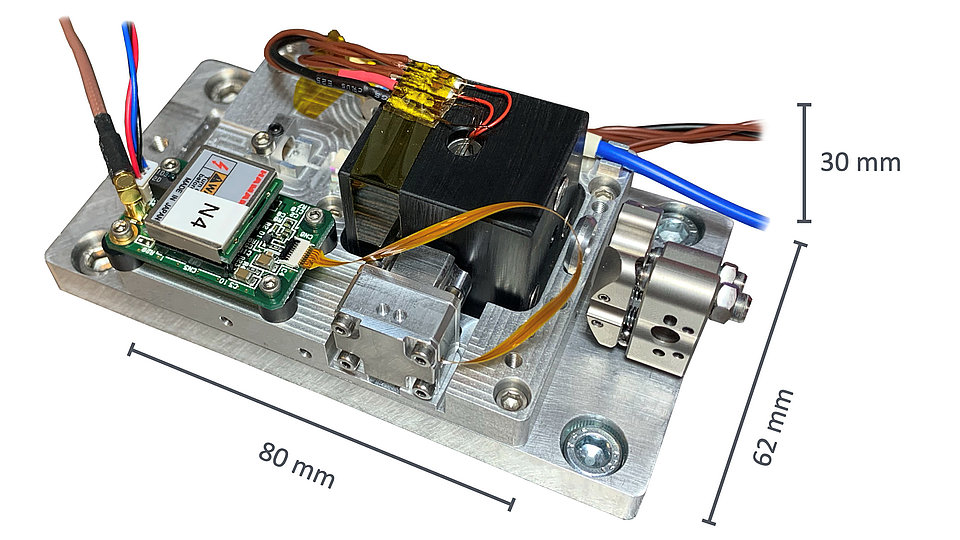Miniaturized rubidium two-photon optical frequency references driven by monolithically integrated extended cavity diode laser
Fig. 1: Prototype of the miniaturized rubidium two-photon optical frequency references developed in the CRONOS project.
Optical frequency references (OFRs) based on frequency modulation spectroscopy of atomic vapor are promising candidates for realizing compact optical clocks. These clocks are considered for applications such as global navigation satellite systems (GNSS) and deep space navigation. Outside the laboratory, especially in space, stringent size, weight, and power requirements (SWaP) must be met while maintaining excellent frequency stability. We have developed a compact optical frequency reference using a novel monolithically integrated extended cavity diode laser (mECDL) at 778.1 nm as a light source.
The CRONOS (Compact Rubidium Oscillator for Navigation systems Onboard a Satellite) payload aims to demonstrate a micro-satellite-based optical clock in low Earth orbit. This payload includes a compact optical frequency reference designed at Ferdinand-Braun-Institut and Humboldt-Universität zu Berlin, a frequency comb from Menlo Systems, and will be integrated in a satellite bus from Technische Universität Berlin. The miniaturized rubidium reference, shown in Fig. 1, utilizes the two-photon 5S-5D transition and has a volume of less than half a liter, a mass below one kilogram, and an estimated power consumption below 10 W. Hot atomic vapor is contained in a 1 cm short heated gas cell, temperature-stabilized to 100 °C with a stability better than 1 mK over timescales shorter than 1000 s. It is designed as a self-contained device within a titanium housing, including magnetic shielding, optics for laser beam alignment, and photo-detectors. 420 nm fluorescence light from the driven two-photon transition is spectrally filtered from spuriously scattered interrogation light and collected onto a SI-photomultiplier. In ongoing measurements, an early testbed reference of the project already surpassed a fractional frequency instability milestone of 1 x 10-12 at 1 s, using a laboratory-based fiber laser.
Furthermore, the prototype of the miniaturized frequency reference was used in conjunction with the mECDL, forming a chip-scale light source at the 778.1 nm two-photon transition. The small size, high optical power output, and comparably narrow spectral emission linewidth make the mECDLs suitable for compact photonic integrated systems such as optical frequency references. For first demonstrations, the laser chip was bonded on a C-mount as shown in Fig. 2. The chip is temperature-stabilized, and the light passes through an optical isolator before being coupled into a polarization-maintaining fiber to guide it into the reference. We use frequency modulation spectroscopy to resolve the hyperfine structure and discipline the laser onto the 87Rb 5S1/2 F = 2 to 5D5/2 F = 4 transition. The spectrum of the four hyperfine states of this transition, as measured with the mECDL, is shown in Fig. 3.
Using an optical heterodyne frequency measurement against a laboratory-based reference, the free-running and locked linewidths of the laser were estimated to be 390 kHz and 290 kHz at 1 ms, respectively. The same method was employed to measure the fractional instability of the compact reference driven by the mECDL. The prototype reference yielded a short-term stability of 2 x 10-12/√τ up to 3 x 10-13 at 1000 s. This is equivalent to approximately 2 picoseconds of time deviation per second. These promising results show the feasibility of miniaturizing complete optical two-photon frequency references into matchbox-sized units suitable for deployment in challenging environments, including space.
This work is carried out in a collaboration between Ferdinand-Braun-Institut and Humboldt-Universität zu Berlin. It is supported by the German Space Agency (DLR) with funds provided by the Federal Ministry of Economic Affairs and Climate Action (BMWK) due to an enactment of the German Bundestag under grant number 50RK1971, 50RK1972, and 50WM2164.
Publication
Wenzel, S., Brox, O., Della Casa, P., Wenzel, H., Arar, B., Knigge, A., Weyers, M., Wicht, A. (2022, May). Monolithically Integrated Extended Cavity Diode Laser emitting at 778 nm. In CLEO: Applications and Technology (pp. AW4M-5). Optica Publishing Group.


